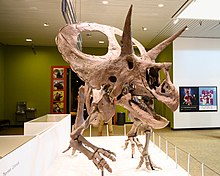| Torosaurus Temporal range: Late Cretaceous (Maastrichtian),
| |
|---|---|

| |
| Specimen nicknamed "Tiny", Denver Museum of Nature and Science | |
| Scientific classification | |
| Domain: | Eukaryota |
| Kingdom: | Animalia |
| Phylum: | Chordata |
| Clade: | Dinosauria |
| Clade: | †Ornithischia |
| Clade: | †Neornithischia |
| Clade: | †Ceratopsia |
| Family: | †Ceratopsidae |
| Subfamily: | †Chasmosaurinae |
| Tribe: | †Triceratopsini |
| Genus: | †Torosaurus Marsh, 1891 |
| Type species | |
| †Torosaurus latus Marsh, 1891
| |
| Other species | |
| |
| Synonyms | |
| |
Torosaurus (meaning "perforated lizard", in reference to the large openings in its frill) is a genus of herbivorous chasmosaurine ceratopsian dinosaur that lived during the late Maastrichtian age of the Late Cretaceous period, between 68 and 66 million years ago, though it is possible that the species range might extend to as far back as 69 million years ago.[1] Fossils have been discovered across the Western Interior of North America, from as far north as Saskatchewan to as far south as Texas.
Torosaurus possessed the largest skulls of any known land animal, with the frilled skull reaching 2.77 metres (9.1 ft) in length. Torosaurus is thought to have been the same size as the contemporary Triceratops,[2][3][4] but is distinguished by an elongated frill with large oval shaped openings, long squamosal bones of the frill with a trough on their upper surface, and the presence of five or more pairs of hornlets on the back of the frill.[5] Torosaurus also lacked the long nose horn seen in Triceratops prorsus. It instead resembled the earlier and more basal Triceratops horridus, thanks to having a short nose horn.[5] Three species have been named so far: Torosaurus latus, T. gladius, and T. utahensis. T. gladius is no longer considered a valid species, however.
In 2010, the validity of Torosaurus was disputed.[6] A study of fossil bone histology combined with an investigation of frill shape concluded that Torosaurus probably represented the mature form of Triceratops, with the bones of typical Triceratops specimens still immature and showing signs of a first development of distinct Torosaurus frill holes. During maturation, the skull frill would have been greatly lengthened and holes would have appeared in it.[7][8][9] In 2011, 2012, and 2013, however, studies of external features of known specimens have claimed that morphological differences between the two genera preclude their synonymy. The main problems are a lack of good transitional forms, the apparent existence of authentic Torosaurus subadults, different skull proportions independent of maturation, and hole formation at an adult stage not being part of a normal ceratopsian maturation sequence.[5][10][11] Consequently, it is still heavily debated whether Torosaurus truly is an adult Triceratops or a separate genus, though most researchers currently favor the latter interpretation.
- ^ *Hicks, J.F., Johnson, K.R., Obradovich, J. D., Miggins, D.P., and Tauxe, L. 2003. Magnetostratigraphyof Upper Cretaceous (Maastrichtian) to lower Eocene strata of the Denver Basin, Colorado. In K.R. Johnson, R.G. Raynolds and M.L. Reynolds (eds), Paleontology and Stratigraphy of Laramide Strata in the Denver Basin, Pt. II., Rocky Mountain Geology 38: 1-27.
- ^ Paul, G.S.; Christiansen, P. (2000). "Forelimb posture in neoceratopsian dinosaurs: implications for gait and locomotion" (PDF). Paleobiology. 26 (3): 450–465. Bibcode:2000Pbio...26..450P. doi:10.1666/0094-8373(2000)026<0450:FPINDI>2.0.CO;2. JSTOR 2666120. S2CID 85280946.
- ^ Paul, G. S. (2010). The Princeton Field Guide to Dinosaurs. Princeton University Press. pp. 265–267. ISBN 978-0-691-13720-9.
- ^ Holtz, Thomas R. Jr. (2012). Dinosaurs: The Most Complete, Up-to-Date Encyclopedia for Dinosaur Lovers of All Ages (PDF).
Winter 2011 Appendix
- ^ a b c Longrich, N. R. & Field, D. J. (2012). "Torosaurus is not Triceratops: Ontogeny in chasmosaurine ceratopsids as a case study in dinosaur taxonomy". PLoS ONE. 7 (2): e32623. Bibcode:2012PLoSO...732623L. doi:10.1371/journal.pone.0032623. PMC 3290593. PMID 22393425.
- ^ "Morph-osaurs: How shape-shifting dinosaurs deceived us – life – 28 July 2010". New Scientist. doi:10.1080/02724634.2010.483632. S2CID 86767957. Retrieved August 3, 2010.
{{cite journal}}: Cite journal requires|journal=(help) - ^ Cite error: The named reference
scannella&horner2010was invoked but never defined (see the help page). - ^ Switek, Brian. "New Study Says Torosaurus=Triceratops". Dinosaur Tracking. Smithsonian.com. Archived from the original on November 13, 2013. Retrieved March 2, 2011.
- ^ Horner, Jack (November 2011). Shape-shifting Dinosaurs. TEDX Talks. Retrieved November 20, 2012.
- ^ Cite error: The named reference
farkwas invoked but never defined (see the help page). - ^ Cite error: The named reference
Maiorino2013was invoked but never defined (see the help page).